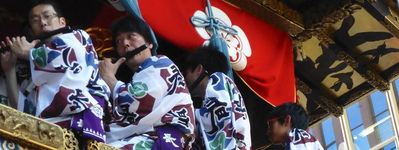I have written earlier about a drawing I made of a dancer at the Gion Matsuri in Kyoto. I made another drawing, this time based on a pictures I took of musicians on a festival float. I’d like to share the background to and the making of the drawing.
The Gion Matsuri
The Gion Matsuri (祇園祭) is Kyoto’s most famous festival, held at the start of summer. The festival itself can be dated back all the way to the Heian era, around 870. It originated as a ritual for purification and pacification of evil spirits causing summer diseases and was at first connected with the Shintō deity of the Gion Shrine (Yasaka Shrine). The festival has been held annually since 970. As early as the late 10th century two types of floats were paraded through the streets accompanied by musicians, dancers, and actors.
During the Edo period (1600 to 1868) the matsuri became a way in which merchants could show off their wealth as well as their international outlook. In that period, the decoration of the floats became more detailed and luxurious and many started incorporating foreign artwork. In particular cotton merchants were among the parishioners of the Gion Shrine, so that textiles have always formed an important part of the festival decoration. The floats currently used in the parade mostly date from the end of the Edo era.
The Yamaboko float parade
On the morning of 17 July there is a parade (junkō, 巡行) of festival floats through the streets of the city. There are two float types, yama (山, meaning “mountain” but also “festival float”) and hoko (鉾, meaning both “festival float” and “halberd”), hence the name yamaboko junkō (山鉾巡行).
The Koi Yama
The yama is a rectangular box containing an artificial mountain crowned by a tree, usually a pine. Textiles decorate the four sides. This type of float is carried through the streets on the shoulders of young men.
I want to mention one of these yama in particular, although it has nothing to do with my drawing. The koi yama (鯉山, “carp float”) features a huge carp swimming upstream towards the sky. This refers to the Chinese legend about a carp who desired to become a dragon and had to go through many trials to reach the Dragon Gate Waterfall.
What is particularly interesting about the Koi Yama float are the decorations: they consist of parts of an authentic 16th-century Flemish tapestry depicting scenes of the Trojan War.
It was quite a surprise to me to find a Flemish tapestry decorating a festival float in Kyoto. So I wanted to find out more, and this is the story:
In the 16th century, Flemish tapestries were luxury items coveted throughout Europe, and common as diplomatic gifts. The Japanese nobles were particularly interested in images of warriors [3].
The Koi Yama tapestry was part of a set of six created by the atelier of the Flemish weaver Nicaise Aerts in Brussels in the 1590s, probably based on cartoons by the famous Michel Coxie. There are different theories of how they came to Japan. The could have been brought to Japan by the Portuguese on request of the Jesuits around 1605 [3] as a gift to the first Tokugawa shōgun Ieyasu, or by the Netherlands East India Company (Vereenigde Oostindische Compagnie; VOC) in 1633 [1], as a diplomatic gift to the third Tokugawa shōgun Iemitsu. Or maybe they could have been gifts from Pope Paolo V to daimyō Date Masamune’s diplomatic/trade mission to Europe, and entered Japan as contraband just as the Tokugawa shōgun closed Japan to limit foreign influence (in 1633) [4].
Later, when the power moved from the shōguns to the merchant classes, the tapestries were sold on. One was lost early on and one during a fire in 1909, but the other four, though mostly cut up, still survive. Around 1800, one of them was acquired to serve as decoration for the Koi Yama, and cut into nine pieces using “a carpenter’s chisel” (daiku no nomi, 大工のノミ) [2].
There is some dispute as to the scenes depicted on the Koi Yama tapestries, as indeed on the other tapestries in the set: some scholars say they are from the Illiad, and show King Priam and Queen Hecuba [2]; others say the set is based on the Aeneid and that the Koi Yama tapestry shows the Roman emperor Augustus, the descendant of Aeneas [3].
- [1] Tapestries Brought to Japan through the Maritime Silk Road and Their Influence, Masako Yoshida, Professor, Kyoto City University of Arts, 2018
- [2] (Koi Yama official web site) 鯉山町衆, 公益財団法人鯉山保存会, 2015
- [3] Sixteenth-Century European Tapestries in Tokugawa Japan, Grace A. H. Vlam, The Art Bulletin Vol. 63, No. 3 (Sep., 1981), pp. 476-495
- [4] Koi Yama 鯉山 The Carp That Became A Dragon, C. Pawasarat, 2019
The Naginata Hoko
The hoko is a tall, rectangular tower with a steepled roof, placed on huge wooden wheels. Underneath the roof there is room for musicians and actors, or dolls representing heroes and heroines from the legendary or historical past. All four sides of the tower are hung with textiles. This type of float is pulled through the streets by teams of thirty to forty men.
There are 32 floats in the Yamaboko Junko, and each year their order is decided by lots drawn officially by the Mayor of Kyoto, except for one: the Naginata Hoko (長刀鉾) always leads the procession. The name comes from the naginata, a long sword or halberd, that decorates its central pole.
Legendary Heian swordsmith Sanjō Munechika (Sanjō no Kokaji) crafted the original halberd sword in the 10th century. The halberd is said to have the power to exorcise the evil spirits which cause epidemics.
When I was at the yoiyama (宵山, the day before the parade) in 2012 I took a few pictures of musicians in a hoko, and it was only when I decided to make a drawing based on it that I realised this is not just a float, but the famous Naginata Hoko. There is a lot more to be said about this particular float, I have provided some links below.
Kitsune masks and yukata
I decided to give the characters in the drawing fox masks to make the scene more distinct.
Fox masks (kitsune men, 狐面) have a long tradition in Japan. In Shinto, the fox is a messenger of the god (kami, 神) Inari, who is the protector of rice, agriculture, and fertility. The gods themselves can take on fox shapes. The mask are use in Noh, Shinto music and dance (kagura, 神楽) and kabuki performances and worn at many festivals – and of course by Babymetal’s Kami band.
I was particularly inspired by the mask worn by the character Gin in the wonderful anime Hotarubi no Mori e (蛍火の杜へ, “To the Forest of the Light of the Fireflies”), but I researched other mask variants as well, in particular because the musicians have to wear half-masks.
The musicians in my drawing wear the same summer kimonos (yukata) as in the picture, save a few minor details, but for the other characters I used different patterns based on other pictures I took.
The drawing
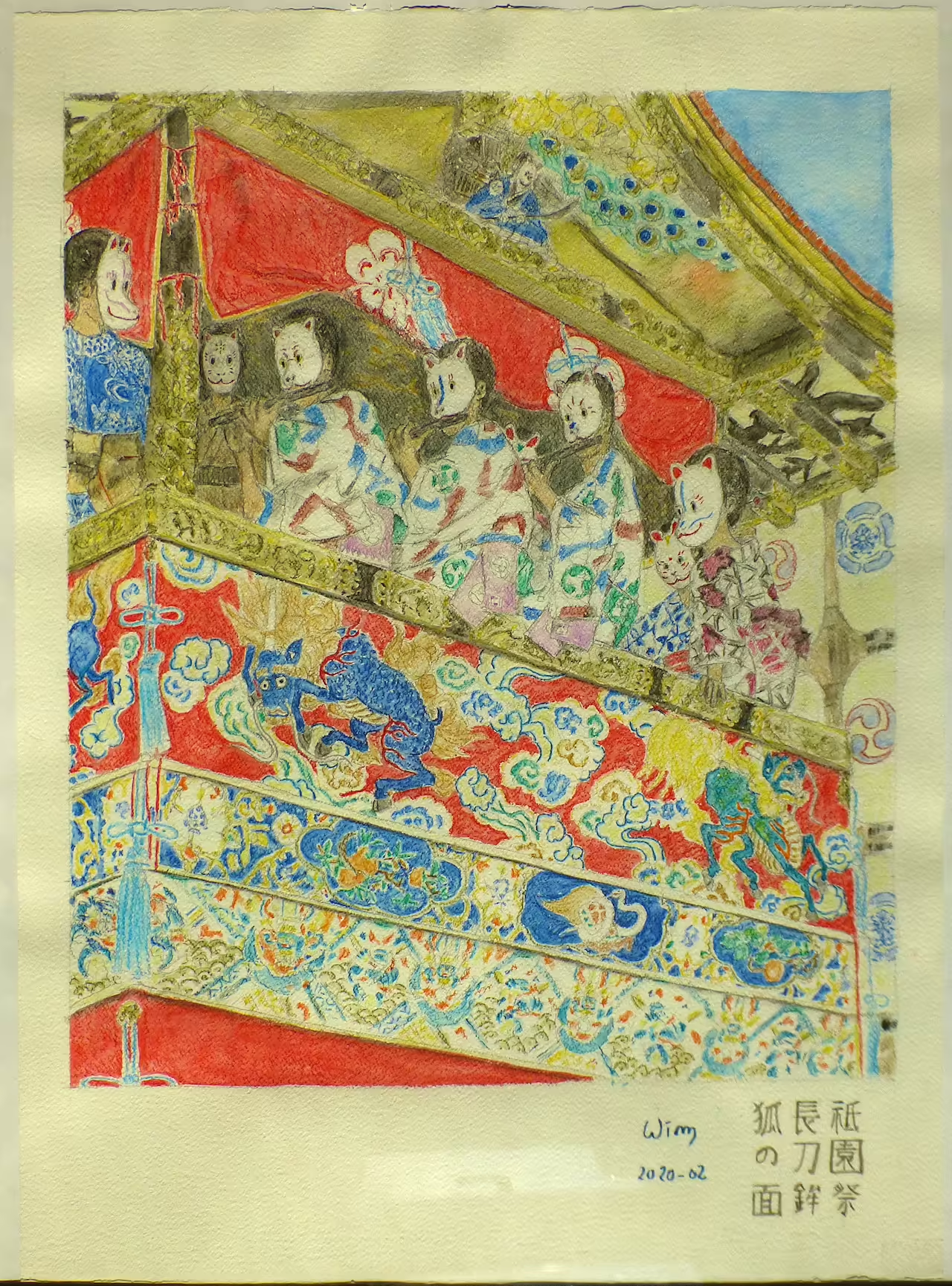
Just like the Ranryōō dancer drawing, I wanted a drawing with bright colours and a lot of detail, and the float has really abundant detail and colour. It is quite amazing how every part of the surface has some detailed decoration. I think I now appreciate the float a lot more because to draw it I had to study every little detail in the picture. I also like to have human figures in my drawings. I think the fox masks make the scene more interesting than the original picture.
The paper for this drawing is Fabriano Artistico 56cm x 76cm 300g/m2 “rough” watercolour paper. It’s a really nice paper with a very pronounced grain. As usual I did not tape it on a board but it only buckled a little.
I used mainly Derwent Inktense, which do give quite deep colours, but also Conté Aquarelle and Faber-Castell Graphite Aquarelle pencils.
As usual I started the drawing with a ghost drawing in pencil. Because of the size of the drawing, I used a grid to make sure the figure was positioned correctly. The focus of detail is on the characters and in particular the masks, the further away from these the more sketchy and impressionistic I treated the drawing.
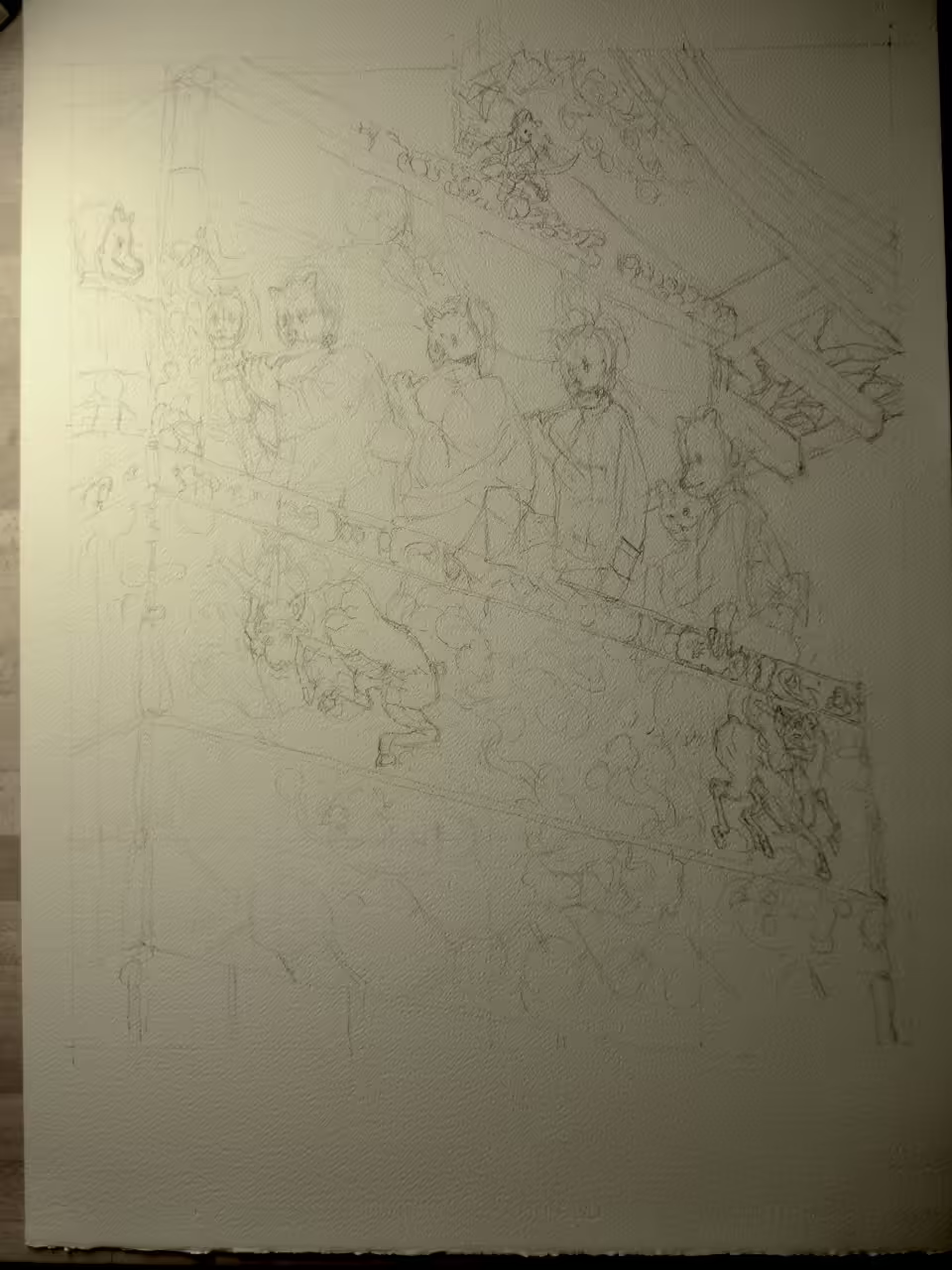
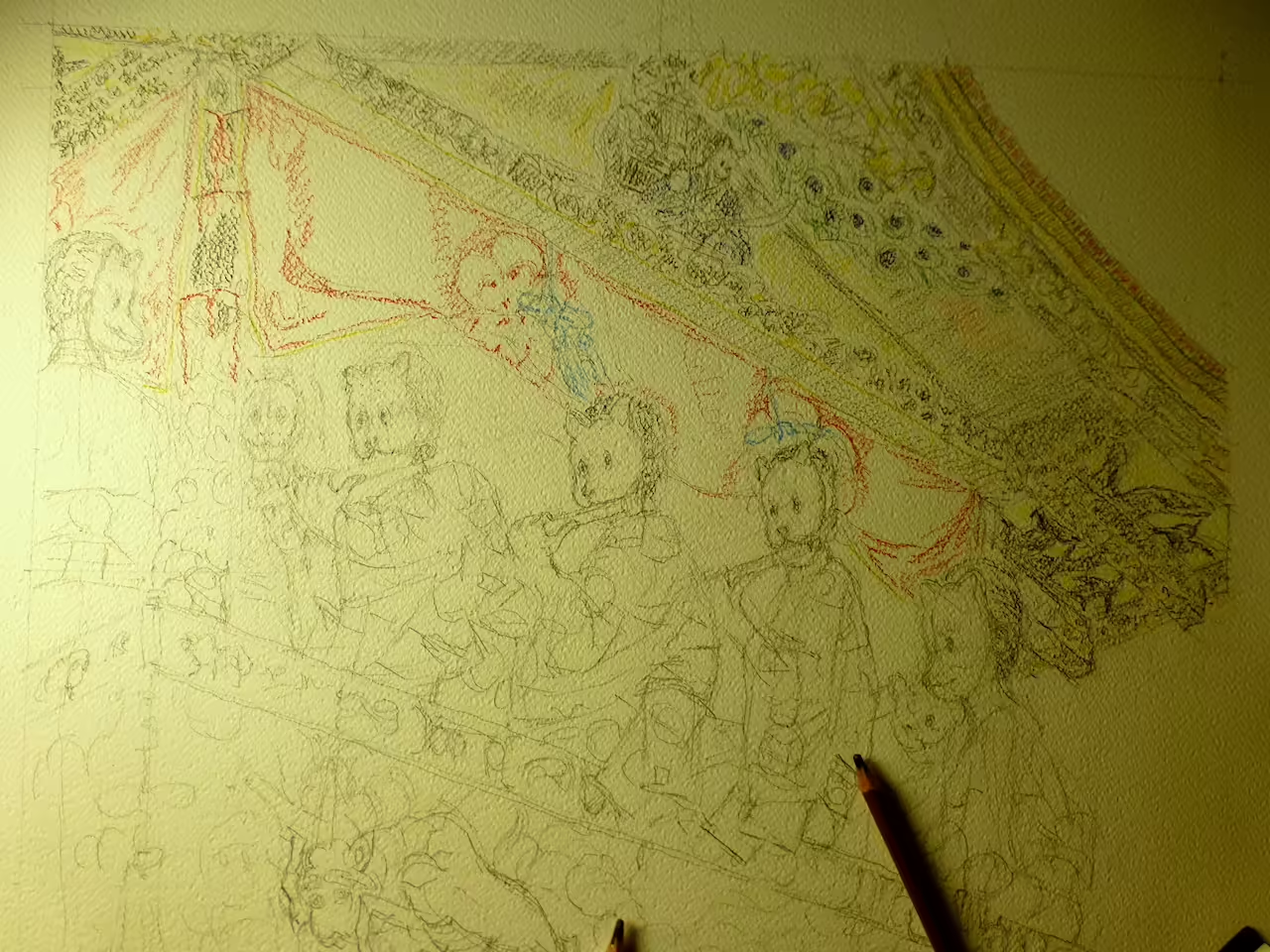
Then I added detail and colour with the watercolour pencils. The float has a lot of gold and silver on the hangings, and these are very difficult to render in colour pencil. The level of details is such that to really reproduce it would require very smooth paper and very fine brushes. I picked the coarse paper on purpose and the pencils are not particularly sharp. This forces me to abstract a lot of the detail.
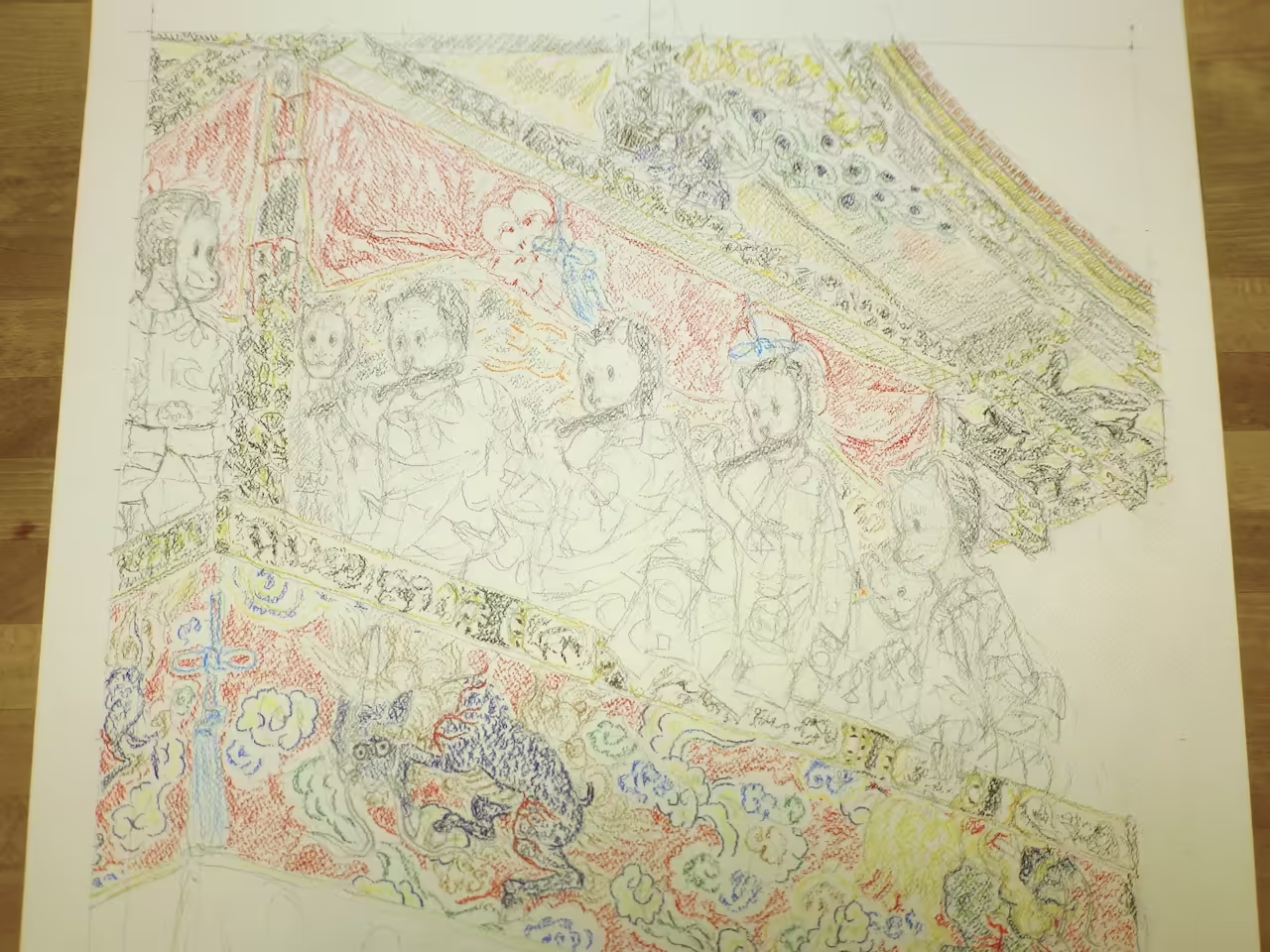
Next I did some separate sketches for the non-musician characters, because they are to my mind very important in this drawing.
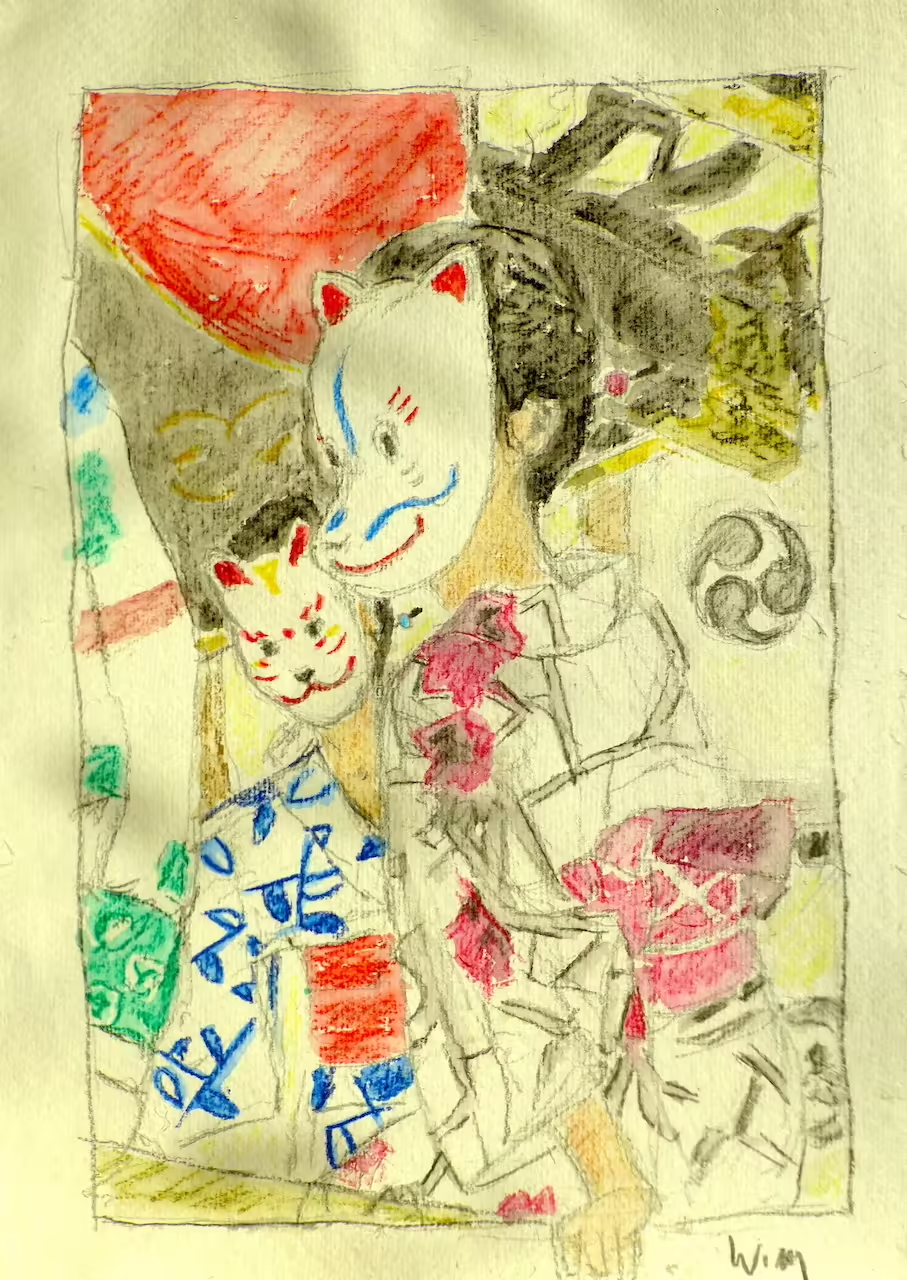
I left the characters until the end and washed the watercolours starting from the bottom.
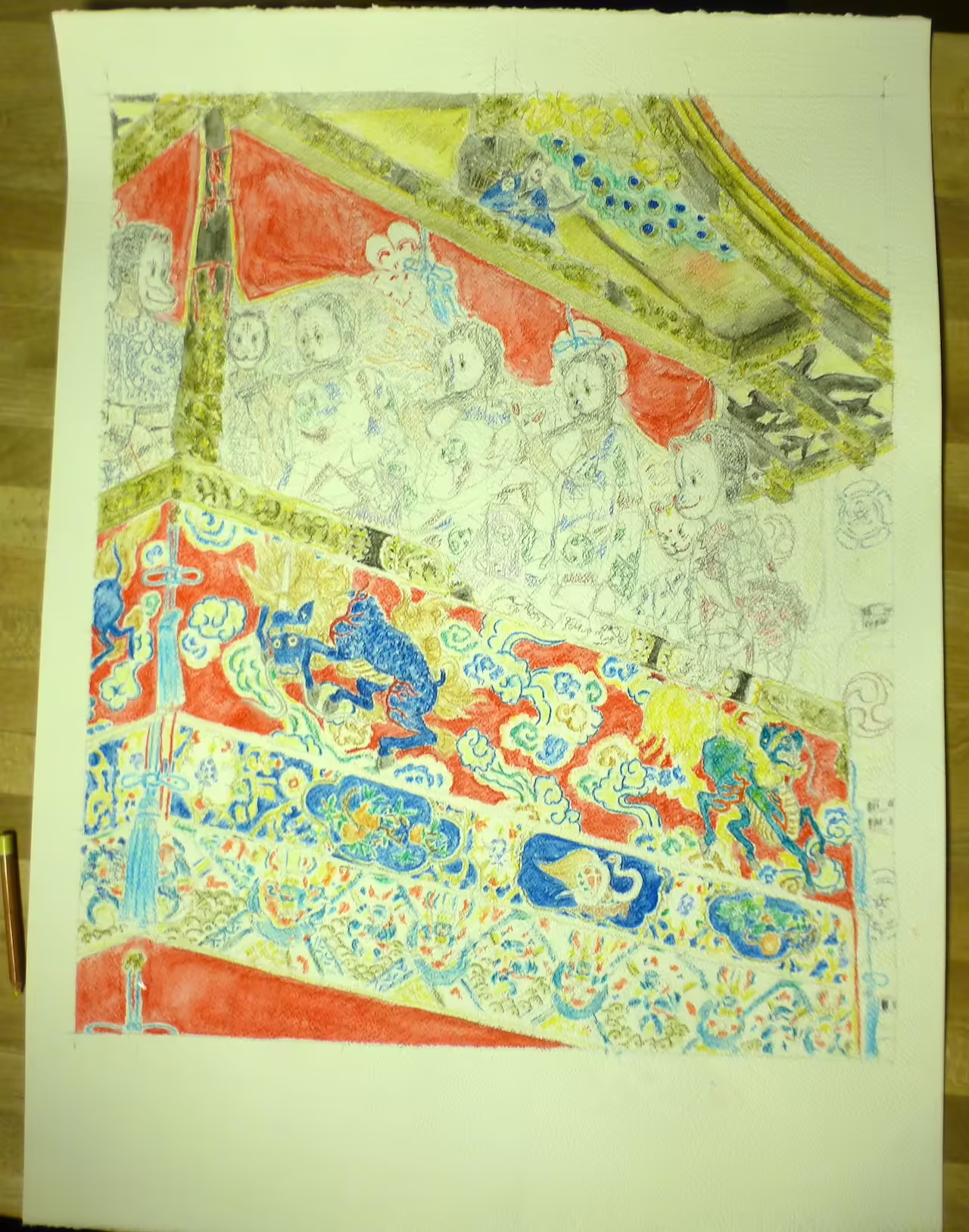
Finally I did the characters. The eyes on the masks are the only places where I used a very fine brush, because a tiny change in the shape can make a big change in expression. Then I did another pass of the entire drawing. I darkened the background behind the characters and the ceiling to have more contrast.
To finish the drawing I added a description in Japanese:
狐 長 祇
の 刀 園
面 鉾 祭
which reads Gion matsuri naginata hoko kitsune no men and means “Gion festival / Halberd float / Fox masks”. The “の” is not really required but I wanted the characters to form a 3x3 grid.
Further reading
- Discover Kyoto page on the Gion festival
- Offical Gion festival page on the naginata hoko
- Offical Gion matsuri page on the naginata hoko (Japanese and English)
- A page on the role of a chigo ritual
- Offical Kyoto City page on the yamaboko (in Japanese)
- Offical Kyoto City page on the naginata hoko (in Japanese)
